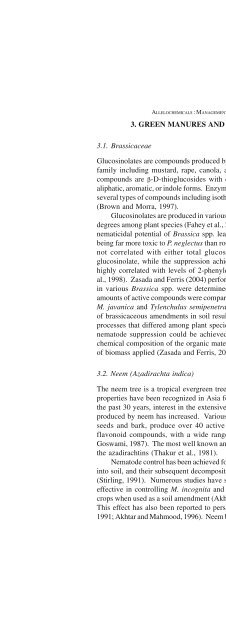Allelochemicals Biologica... - Name
Allelochemicals Biologica... - Name
Allelochemicals Biologica... - Name
You also want an ePaper? Increase the reach of your titles
YUMPU automatically turns print PDFs into web optimized ePapers that Google loves.
3.1. Brassicaceae<br />
ALLELOCHEMICALS : MANAGEMENT OF PLANT-PARASITIC NEMATODES 21<br />
3. GREEN MANURES AND ORGANIC AMENDMENTS<br />
Glucosinolates are compounds produced by many members of the Brassicaceae plant<br />
family including mustard, rape, canola, and cabbage (Fahey et al., 2001). These<br />
compounds are β-D-thioglucosides with differing organic side chains, and can be<br />
aliphatic, aromatic, or indole forms. Enzymatic degradation of glucosinolates produces<br />
several types of compounds including isothyocyanate (ITC), a well known nematicide<br />
(Brown and Morra, 1997).<br />
Glucosinolates are produced in various levels throughout the plant and to different<br />
degrees among plant species (Fahey et al., 2001). In studies by Potter et al. (1998) the<br />
nematicidal potential of Brassica spp. leaf and root tissue differed, with leaf tissue<br />
being far more toxic to P. neglectus than root tissue. However, leaf tissue toxicity was<br />
not correlated with either total glucosinolate content or with any individual<br />
glucosinolate, while the suppression achieved with the addition of root tissue was<br />
highly correlated with levels of 2-phenylethyl glucosinolate within roots (Potter et<br />
al., 1998). Zasada and Ferris (2004) performed studies where levels of glucosinolates<br />
in various Brassica spp. were determined and amendments containing equivalent<br />
amounts of active compounds were compared to determine their efficacy in controlling<br />
M. javanica and Tylenchulus semipenetrans. They determined that the degradation<br />
of brassicaceous amendments in soil resulted in a series of biological and chemical<br />
processes that differed among plant species. It was also determined that consistent<br />
nematode suppression could be achieved using brassicaceous amendments if the<br />
chemical composition of the organic material was considered and appropriate levels<br />
of biomass applied (Zasada and Ferris, 2004).<br />
3.2. Neem (Azadirachta indica)<br />
The neem tree is a tropical evergreen tree native to India whose biologically active<br />
properties have been recognized in Asia for centuries (Thakur et al., 1981). During<br />
the past 30 years, interest in the extensive variety of biologically active compounds<br />
produced by neem has increased. Various parts of the neem plant including leaves,<br />
seeds and bark, produce over 40 active diterpenoid, triterpenoid, limonoid, and<br />
flavonoid compounds, with a wide range of nematicidal activity (Bhatnagar and<br />
Goswami, 1987). The most well known and active compounds produced by neem are<br />
the azadirachtins (Thakur et al., 1981).<br />
Nematode control has been achieved following the incorporation of neem products<br />
into soil, and their subsequent decomposition and release of nematicidal compounds<br />
(Stirling, 1991). Numerous studies have shown that leaves and oilcake of neem are<br />
effective in controlling M. incognita and increasing growth and yield of vegetable<br />
crops when used as a soil amendment (Akhtar, 1998; Bhatnagar and Goswami, 1987).<br />
This effect has also been reported to persist in successive crops (Akhtar and Alam,<br />
1991; Akhtar and Mahmood, 1996). Neem based products have also shown nematicidal


